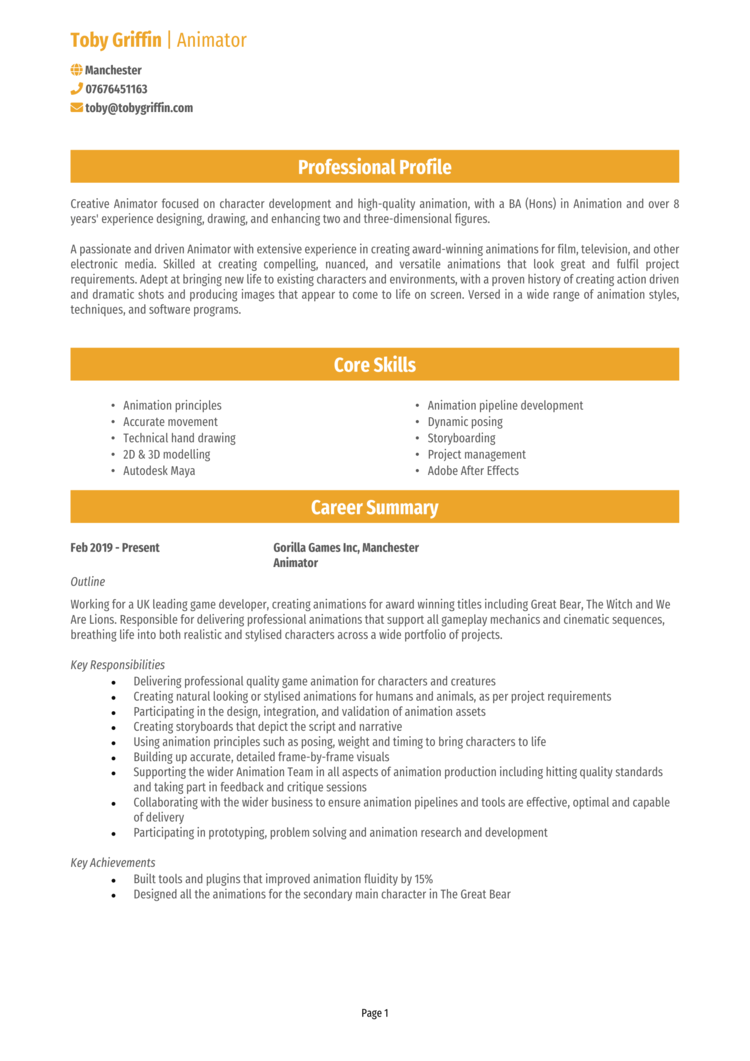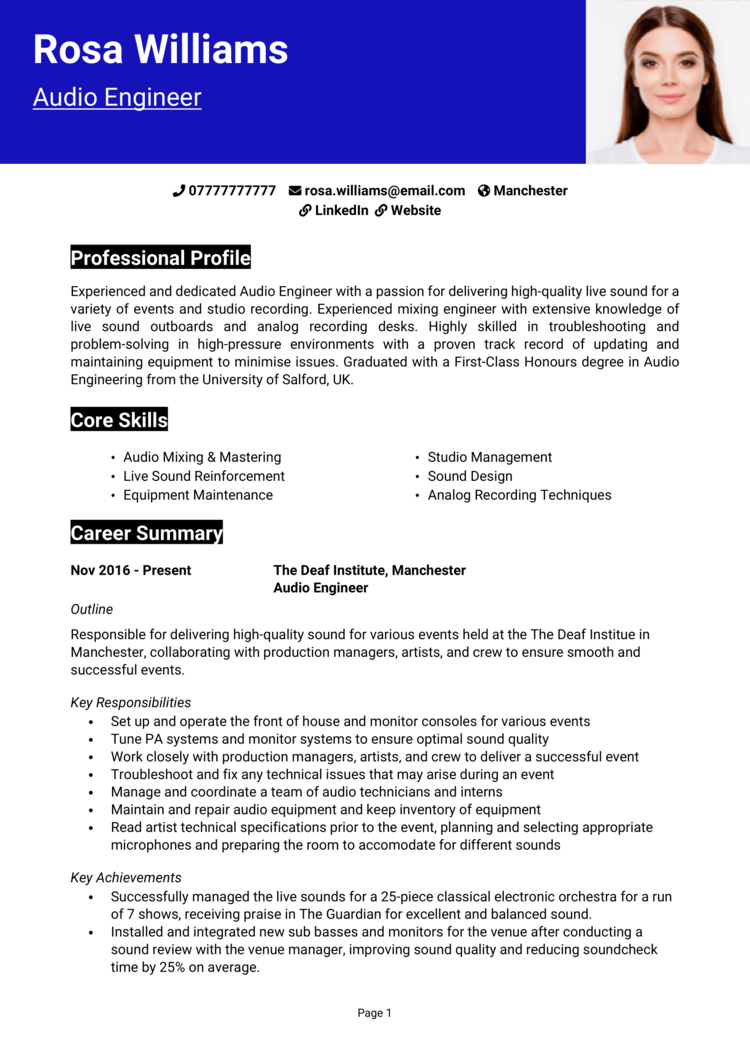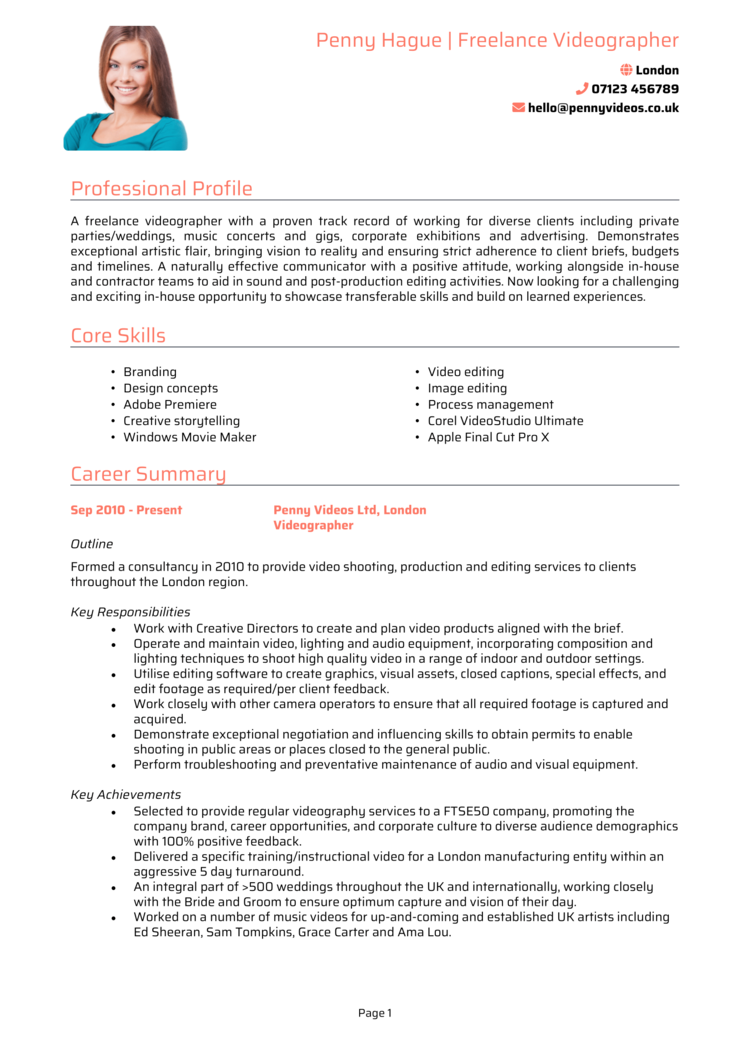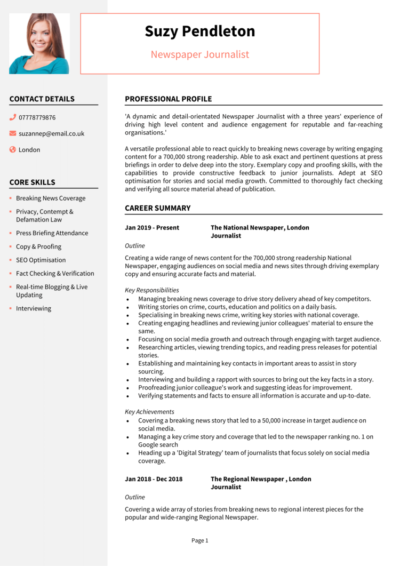Behind every great piece of content is a media professional making it happen. If you want to be the one behind the scenes, your CV will need to grab attention just as effectively.
But to land your next role in this fast-paced industry, your CV needs to do more than list your experience – it needs to show you understand the media landscape and can thrive in its ever-changing environment.
This guide and its Media CV examples will help produce an application which ensures you thrive in this highly competitive field.
Newspaper Journalist CV

Animator CV

Audio Engineer CV

Cameraman CV

Freelance Videographer CV

Production Runner CV

How to write your Media CV
Discover how to craft a Media CV that lands interviews with this simple step-by-step guide.
This guide will walk you through every section of your CV, showing you how to highlight your creative achievements and technical skills to succeed in media roles, whether you’re working in production, content creation, or digital publishing. By the end, you’ll know everything about writing a CV which gets results.
How to create a good structure for your Media CV?


The media industry moves fast, and so do hiring managers. They’ll scan your CV in seconds, so it needs to be clear with a neat structure, and full of the key skills and experience they want to see. If your layout is difficult to navigate, they’ll just move onto the next applicant.
This structure will guide recruiters comfortably through your CV:
- Name and contact details – Place your name and personal details prominently at the top of your CV for quick access. Adding a photo is up to you, but might be good for certain media roles.
- Profile – Start with a punchy summary highlighting your creative expertise, technical skills, and passion for media.
- Core skills – Give a quick snapshot of your most valuable abilities, from content creation to media planning.
- Work experience – Detail your media-related roles, internships, and creative projects in reverse chronological order.
- Education – List your relevant qualifications, from degrees to specialist training.
- Additional info – Optionally mention extra things like awards, relevant memberships, and hobbies.
Media CV format


A media CV should be creative – but not chaotic. Just like a polished broadcast or a perfectly curated feed, your CV should be visually clean and easy to follow. If it’s got noticeable visual mistakes, your skills and expertise will simply be overlooked.
Keep your format professional and modern with these helpful tips:
- Bullet points – Break down responsibilities and achievements into bite-sized information.
- Divide sections – Clear section headings help hiring managers navigate your CV easily.
- Use a clear and readable font – A simple, professional font ensures readability while keeping the layout polished and tidy.
- No more than 2 pages – This gives you the length to detail your experience while keeping it concise enough to respect the recruiter’s time.
Media CV profile


Your profile introduces you to potential employers and should sum up what makes you an outstanding media professional. This is the first thing recruiters are going to see, so make sure you effectively convey the value you’d bring to any media outlet. Your profile is easy to tailor to different roles: if it reads like a generic press release, you’re missing a trick.
Media CV profile examples
Profile 1
Creative and results-driven Media Executive with four years of experience in digital content production, media strategy, and brand storytelling. Skilled in video editing, social media management, and audience engagement. Proficient in Adobe Creative Suite, SEO, and data analytics tools. Passionate about creating compelling media campaigns that captivate audiences and drive brand awareness.
Profile 2
Experienced Media Producer with three years of expertise in television, film, and digital content creation. Adept at scriptwriting, directing, and post-production editing. Skilled in project coordination, working with cross-functional teams, and ensuring high-quality media output. Committed to delivering engaging content that resonates with target audiences.
Profile 3
Dynamic Media Strategist with over six years of experience in media planning, advertising, and campaign development. Skilled in audience research, data-driven marketing, and cross-platform content distribution. Proficient in media buying, PR, and digital advertising strategies. Dedicated to maximising brand visibility through innovative media solutions.
Details to put in your Media CV profile
Here’s what to include:
- Media experience – Mention the types of projects you’ve worked on, whether it’s broadcasting, digital content, or editorial work.
- Technical and creative skills – Highlight your expertise, from video editing to campaign planning.
- Adaptability – Demonstrate your ability to work across different platforms, from traditional to digital media.
- Collaboration – Showcase your experience working with production teams, clients, and creatives.
- Project management – Highlight your ability to keep projects on track, meeting deadlines and creative briefs.
What to include in a Media CV core skills section


This section is your media toolkit – a quick snapshot of the technical and creative skills you bring to every project. Make sure this list reflects the real skills media employers are scanning for, from editing software to campaign coordination.
Media is a diverse field, so tailor the skills for your CV to match the specific role you’re applying for – whether it leans more towards content creation, production management, or media strategy.
Best skills for your Media CV
- Content Creation and Production – Developing engaging multimedia content, including articles, videos, and podcasts for various platforms.
- Digital Media Strategy – Planning and executing campaigns across social media, websites, and digital advertising channels.
- Video Editing and Post-Production – Editing footage, adding graphics, and optimising video content for distribution.
- SEO and Audience Analytics – Using search engine optimisation and analytics tools to track performance and engagement.
- Social Media Management – Managing brand presence across platforms like Instagram, Twitter, Facebook, and LinkedIn.
- Journalism and Reporting – Researching, writing, and delivering news stories or features with accuracy and credibility.
- Public Relations and Crisis Management – Handling brand reputation, press releases, and media relations.
- Scriptwriting and Storytelling – Crafting compelling narratives for TV, film, radio, and online content.
- Advertising and Monetisation – Developing media sales strategies, working with sponsors, and managing ad placements.
- Broadcast and Live Production – Operating cameras, sound equipment, and managing live event coverage.
Work experience


Media employers want to see evidence of real, impactful work – not just job titles. Your work experience should highlight your technical contributions and the results or recognition they received.
List your roles in reverse chronological order, starting with the most recent. If you’re early in your career, include internships or freelance projects, or even university work that’s directly relevant to the media role you’re applying for.
How should you list jobs on your Media CV?

- Outline – Briefly describe the organisation, the type of media produced, and your role in the team.
- Responsibilities – Explain your key tasks, such as editing video content, writing scripts, managing schedules, or coordinating with clients. Use action words like “produced,” “edited,” and “coordinated.”
- Achievements – Showcase your creative impact, like launching a successful campaign, receiving industry recognition, or delivering a project ahead of schedule.
Work experience samples for Media roles
Media Executive | Nova Spark
Outline
For a leading UK digital marketing agency, developed and executed multimedia content strategies to enhance brand presence and audience engagement.
Responsibilities
- Managed content creation across digital platforms, including social media, blogs, and video channels.
- Edited video and graphic content using Adobe Premiere Pro and Photoshop.
- Analysed audience insights and adjusted media strategies to optimise engagement.
- Collaborated with internal teams and external clients to align content with brand objectives.
- Monitored media trends and recommended innovative approaches to content production.
Achievements
- Increased client engagement rates by 40 percent through optimised media campaigns.
- Boosted video views by 60 percent through improved storytelling and audience targeting.
- Recognised for delivering high-impact multimedia campaigns that exceeded client expectations.
Media Producer | Visionary Entertainment
Outline
Within the production team of a global entertainment network, oversaw the production and post-production of media content for television and online platforms.
Responsibilities
- Coordinated with directors, writers, and editors to develop engaging video content.
- Managed the filming process, ensuring adherence to production schedules and budgets.
- Edited and refined media assets using Final Cut Pro and Adobe After Effects.
- Supervised sound design, graphics, and special effects to enhance final productions.
- Ensured compliance with broadcasting standards and copyright regulations.
Achievements
- Produced a documentary series that gained over 5 million views worldwide.
- Successfully managed a £200K production budget, delivering high-quality content on time.
- Awarded ‘Best Emerging Media Producer’ for innovative storytelling techniques.
Media Strategist | Peak Communications
Outline
For a multinational advertising and PR firm, developed and implemented media strategies to drive brand awareness and market engagement.
Responsibilities
- Designed and executed multi-channel advertising campaigns, optimising budget allocation.
- Conducted audience research and data analysis to identify target demographics.
- Managed media buying and placement across TV, radio, and digital platforms.
- Liaised with creative teams to ensure consistent brand messaging and campaign execution.
- Evaluated campaign performance and provided insights for continuous optimisation.
Achievements
- Increased brand visibility for a major client by 50 percent through targeted media planning.
- Managed a £2M media budget, ensuring cost-effective ad placements and maximum ROI.
- Recognised for launching a viral media campaign that reached over 10 million users globally.
How to write your education section


While media careers benefit from a formal education, recruiters focus more on your real-world experience, so keep this section brief.
Simply list your degree (if relevant) and any specialist training, such as media production courses, editing software certifications, or digital marketing qualifications.
Best qualifications for Media
- BA/BSc in Media Studies, Journalism, or Broadcasting – Directly relevant degrees for many media careers.
- Diploma in Creative Media Production & Technology – Ideal for hands-on technical skills.
- Adobe Certified Professional (Premiere Pro, Photoshop) – Great for production and content roles.
- Digital Marketing Qualification (CIM or Google) – Valuable for digital-focused roles.
- Project Management Training (PRINCE2, Agile) – Useful for production coordination roles.





